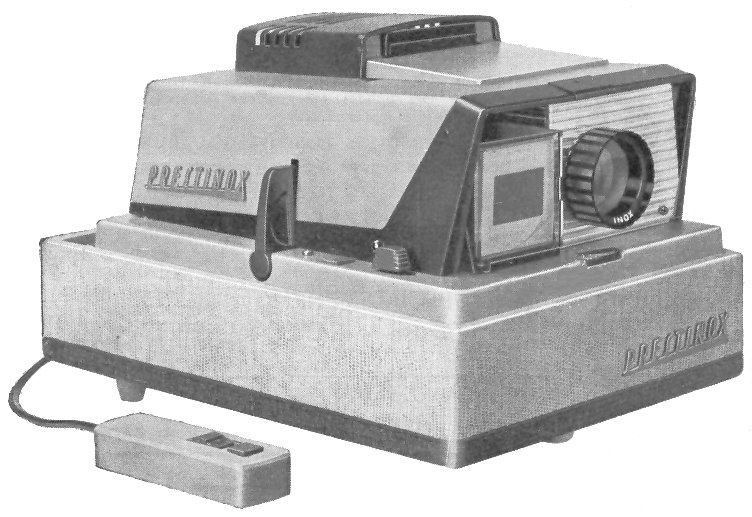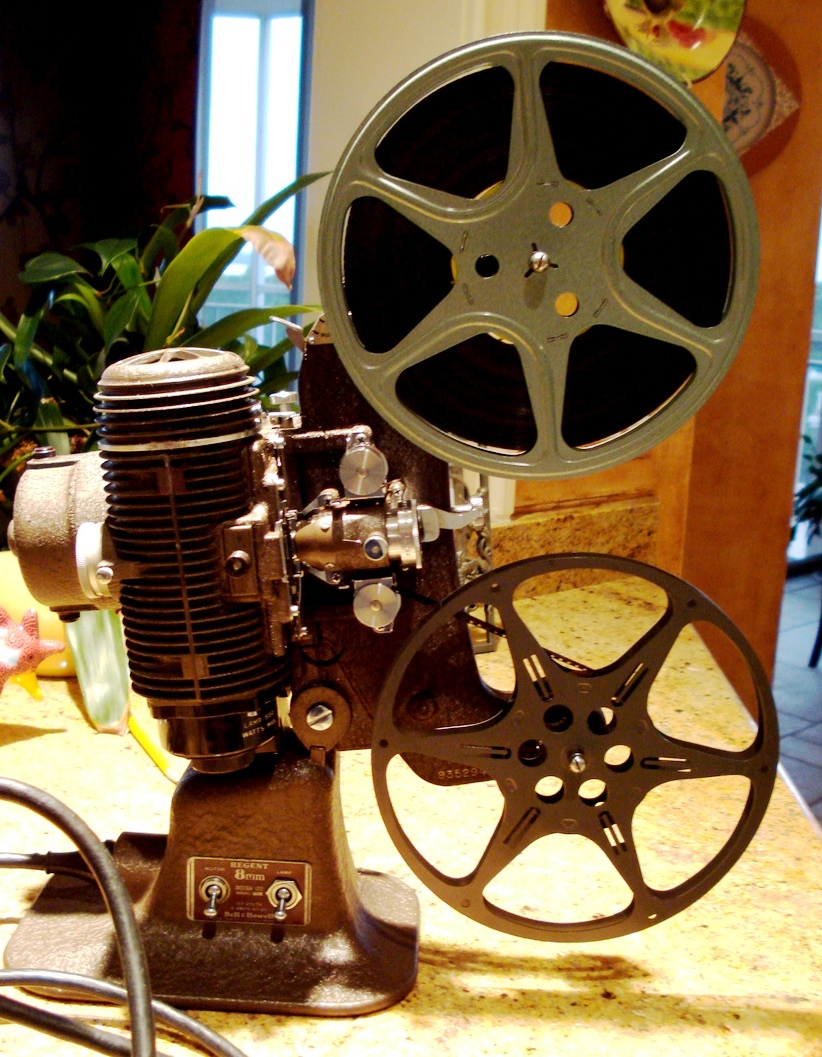|
Slide Cube Projector
The Slide Cube Projector is a slide projector and system, manufactured and marketed by Bell & Howell. Introduced in 1970 and marketed through the 1980s, the projector derived its name from its plastic slide storage cube-shaped magazine, about 5.5 cm in each dimension (a bit larger than a slide), and held 36–44 slides, depending on the mount thickness. Each cube had an operable sliding lid to hold the slides in the cube. The system consisted of Slide Cubes and a special projector to receive the cubes. Bell and Howell subsequently introduced a Slide Cube Projector II, with revised features. Unlike trays used in straight-tray slide projector or carousel slide projectors, the slides in a Slide Cube are not stored in separate slots, rather they are stacked together, one on top of the other. After a cube is manually set into the PRE-LOAD position and then manually slid into the LOAD position, the action causes the cube's lid to open. The advance trigger is activated, a sequence ... [...More Info...] [...Related Items...] OR: [Wikipedia] [Google] [Baidu] |
Slide Projector
A slide projector is an opto-mechanical device for showing photographic slides. 35 mm slide projectors, direct descendants of the larger-format magic lantern, first came into widespread use during the 1950s as a form of occasional home entertainment; family members and friends would gather to view slide shows. Reversal film was much in use, and supplied slides snapped during vacations and at family events. Slide projectors were also widely used in educational and other institutional settings. Photographic film slides and projectors have mostly been replaced by image files on digital storage media shown on a projection screen by using a video projector or simply displayed on a large-screen video monitor. History A continuous-slide lantern was patented in 1881. It included a dissolving views apparatus.Sloane, T. O'Conor. ''Facts Worth Knowing Selected Mainly from the Scientific American for Household, Workshop, and Farm Embracing Practical and Useful Information fo ... [...More Info...] [...Related Items...] OR: [Wikipedia] [Google] [Baidu] |
Bell & Howell
Bell and Howell LLC is a U.S.-based services organization and former manufacturer of cameras, lenses, and motion picture machinery, founded in 1907 by two projectionists, and originally headquartered in Wheeling, Illinois. The company is now headquartered in Durham, North Carolina, and currently sells production mail equipment, buy-online-pickup-in-store (BOPIS) smart locker and kiosk solutions, and provides maintenance services for automated, industrial equipment in enterprise-level companies. Since 2010, the Bell + Howell brand name has been extensively licensed for a diverse range of consumer electronics products. History According to its charter, the Bell & Howell Company was incorporated on February 17, 1907. It was duly recorded in the Cook County Record Book eight days later. The first meeting of stockholders took place in the office of Attorney W. G. Strong on February 19 at 10 a.m. (10:00 CT). The first board of directors was chosen for a term of one year: Donald Jo ... [...More Info...] [...Related Items...] OR: [Wikipedia] [Google] [Baidu] |
Camera Magazine
A camera magazine is a light-tight chamber or pair of chambers designed to hold film and move motion picture film stock before and after it has been exposed in the camera. In most movie cameras, the magazine is a removable piece of equipment. Many still photo cameras also have removable camera magazines. A film cartridge serves the same function, but is usually not reusable. Lengths In 16 mm filmmaking, most magazines are designed to accommodate up to 400 feet of film stock, which usually is the longest standard roll size available from film manufacturers (longer rolls can be made upon special request sometimes, but require special magazines). In 35mm filmmaking, there tend to be three common magazine types - 1000 foot magazines, which accommodate the longest standard roll size of 35 mm film; 400 foot magazines, which are often used when the camera is handheld in order to minimize the amount of weight upon the camera operator; and 400 foot Steadicam magazines, which are sp ... [...More Info...] [...Related Items...] OR: [Wikipedia] [Google] [Baidu] |
Carousel Slide Projector
A carousel slide projector is a slide projector that uses a rotary tray to store slides, used to project slide photographs and to create slideshows. It was first patented on May 11, 1965, by David E. Hansen of Fairport, New York. Hansen was an industrial designer at the Eastman Kodak Company. A patent for the rotary tray was granted in 1966 after a 1962 application by the Eastman Kodak Company. The original concept for the carousel slide projector is credited to Italian-American Louis Misuraca, who brought his design to the Kodak company, and sold it for a lump sum. Kodak released their first Carousel projector, the Model 550, in 1961 and sold it until 1966. The 1963 Carousel Model S (Carousel-S), a professional model sold only in Germany, was designed by Hans Gugelot and Reinhold Häcker for Kodak AG in Stuttgart and is in the permanent collection of the Museum of Modern Art. Physical form A separate, circular tray holds several (usually 80 or 140) 35mm slides, and is filled wi ... [...More Info...] [...Related Items...] OR: [Wikipedia] [Google] [Baidu] |
Slideshow
A slide show (slideshow) is a presentation of a series of still images ( slides) on a projection screen or electronic display device, typically in a prearranged sequence. The changes may be automatic and at regular intervals or they may be manually controlled by a presenter or the viewer. Slide shows originally consisted of a series of individual photographic slides projected onto a screen with a slide projector. When referring to the video or computer-based visual equivalent, in which the slides are not individual physical objects. A slide show may be a presentation of images purely for their own visual interest or artistic value, sometimes unaccompanied by description or text, or it may be used to clarify or reinforce information, ideas, comments, solutions or suggestions which are presented verbally. Slide shows are sometimes still conducted by a presenter using an apparatus such as a carousel slide projector or an overhead projector, but now the use of an electronic video d ... [...More Info...] [...Related Items...] OR: [Wikipedia] [Google] [Baidu] |
Franke & Heidecke Rolleiscop
Rollei () was a German manufacturer of optical instruments founded in 1920 by and in Braunschweig, Lower Saxony, and maker of the Rolleiflex and Rolleicord series of cameras. Later products included specialty and nostalgic type films for the photo hobbyist market. Originally named ''Werkstatt für Feinmechanik und Optik, Franke & Heidecke'', the company renamed into ''Rollei-Werke Franke & Heidecke GmbH'' in 1972, ''Rollei-Werke Franke & Heidecke GmbH & Co. KG'', in 1979, and ''Rollei Fototechnic GmbH & Co. KG'' in 1981. After being purchased in 1995 by Samsung Techwin, part of the South Korean Samsung Group, it was sold back to its internal management in 1999. In 2002, it was bought by a Danish investment group, and renamed ''Rollei GmbH'' in 2004. In 2005/2006, the company headquarters moved to Berlin and the company was split into two different companies: ''Rollei GmbH'' in Berlin, owner of the Rollei brand and selling various OEM equipment, and ''Rollei Produktion GmbH'' ... [...More Info...] [...Related Items...] OR: [Wikipedia] [Google] [Baidu] |




_(cropped).jpg)